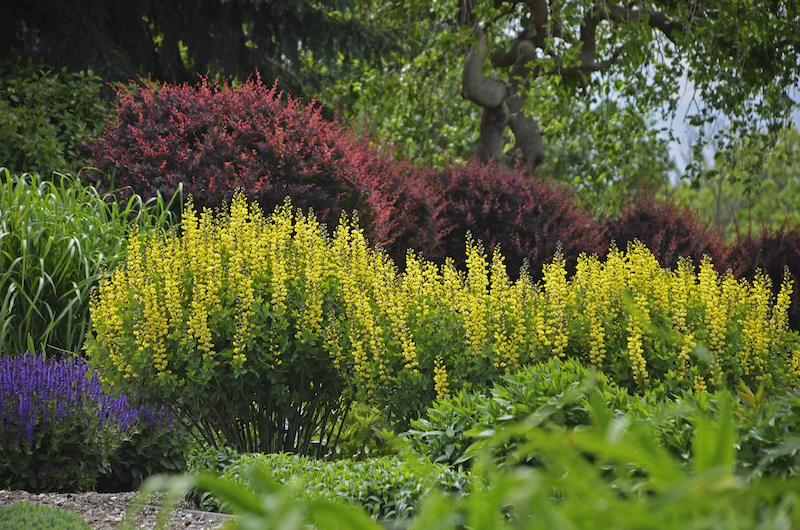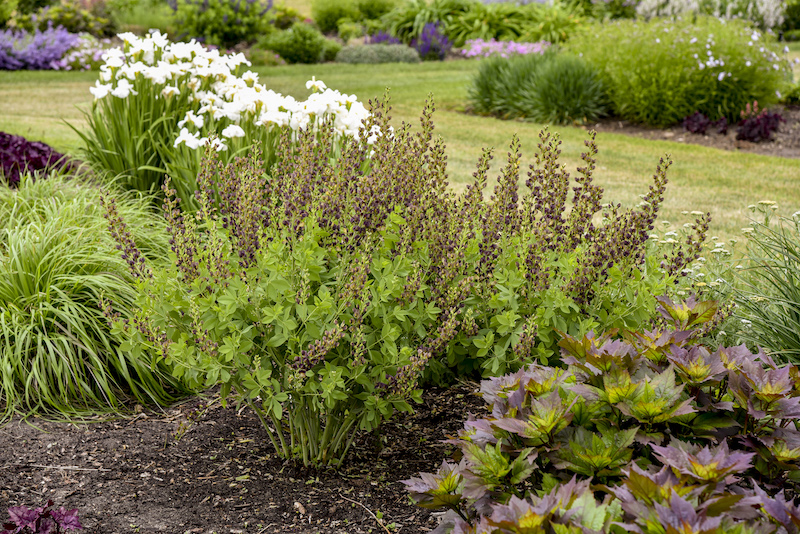False Indigo is a North American native with a shrub-like form, and established plants grow with very little care. The showy flowers grow on tall spikes that can reach several feet high, depending on the variety. Flowers can be a deep blue, yellow, or bi-color, allowing you to choose the colors that best match your desired look. The flowers start to bloom in late spring and generally last until mid-summer. This perennial is an excellent pick to create a prairie-inspired landscape with hardy favorites like salvia, bee balm, coneflowers, and ornamental grasses.

Shrubs To Plant With False Indigo
Create a border or formal rows using barberry, privet, or boxwood shrubs. These shrubs can grow tall, creating privacy and providing a consistent background for false indigo. The shrubs can be pruned to have a formal shape or allowed to assume an organic form. The evergreen false cypress is another opportunity to add color, character, and height.
The green foliage, white flowers, and dark purplish-blue berries of the elderberry shrub provide a lot of color and texture throughout the growing season. Feature false indigo in front of elderberry so that both plants can be viewed and enjoyed. Oakleaf hydrangea is another flowering shrub that is native, so this bush is low maintenance once it has settled in. This shrub blooms during late spring, so it is a nice leadup to when the false indigo flowers appear.

Photo by K M, unmodified, Flickr, copyright CC BY 2.0
Perennials To Plant With False Indigo
False indigo attracts pollinators and is perfect for creating an easy-care, pollinator-friendly mixed planting with salvia, yarrow, and coneflowers. The flowers of each of these plants have different colors, shapes, and sizes, creating an eclectic space. Feature these plants in organized rows or group them in drifts for a meadow effect.
Ornamental grasses add height and can be used to anchor a mixed planting. The thin, wispy blades of grass complement most plants and add graceful movement to a planting. Feature the false indigo with purple fountain grass for an unexpected but coordinated burst of color.

Annuals To Plant With False Indigo
The rich tones of the false indigo flowers are the main attraction of this perennial. Plant false indigo with boldly colored snapdragons to introduce more vibrant hues and tie the planting together. Add annual lobelia to the mixed bed to create a lovely but more subdued space. The tiny, light purple, blue or white flowers will coordinate with the false indigo, adding texture and fullness.
Best Companion Plants For False Indigo in Containers
The showy foliage of coral bells adds a colorful base to a container when combined with false indigo. Sedum makes for a low-maintenance addition to a container and adds an entirely different look. The thick, succulent foliage and tiny flower clusters of the sedum provide a contrast against the false indigo.
Plants Not To Grow With False Indigo
Differing care requirements are the main reason not to feature plants alongside the false indigo. The false indigo is an adaptable plant, but full sun and well-drained soil are best. Plants that exclusively require shade or are unable to handle full sun cannot grow with false indigo. Ferns, brunnera and lungwort are plants that simply cannot live and thrive in the same conditions that support the false indigo.
Best Plants To Grow With False Indigo
Plants with purple or blue flowers or berries are an excellent match to the false indigo because they create a coordinated theme. However, this prairie native looks charming with just about anything. Drought-tolerant plants that require full to partial sun will grow well with the false indigo. Privet, salvia, foxglove, yarrow, and elderberry are plants that have similar care needs and create a styled yet natural-looking outdoor space.
 |
Author Alison Cotsonas - Published 10-03-2023 |




